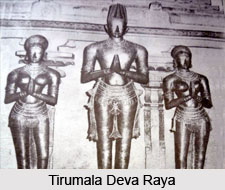 When Rama Raya was slayed in the Talikonda battle in 1565, he instantly vacated the treasury and fled the capital, captivating with him the Royal family and the minor crown prince Sadasiva Raya. Few years down the line, he reestablished the Vijaynagar rule in Penukonda with hardships, in present day Andhra Pradesh. During this time the Southern Nayakas of Madurai and Gingee, declared limited independence, while some others rebelled over Tirumala Deva Raya`s authority.
When Rama Raya was slayed in the Talikonda battle in 1565, he instantly vacated the treasury and fled the capital, captivating with him the Royal family and the minor crown prince Sadasiva Raya. Few years down the line, he reestablished the Vijaynagar rule in Penukonda with hardships, in present day Andhra Pradesh. During this time the Southern Nayakas of Madurai and Gingee, declared limited independence, while some others rebelled over Tirumala Deva Raya`s authority.
In 1567 he encountered another attack by the Bijapur Sultan, this time the Sultan was defeated but also losing some territories. Tirumala Deva Raya later tactfully approved the new status of Southern Nayaks, who still paid some tributes and held him as their emperor.Tanjore and Mysore rulers still paid the annual tributes while Madurai and Gingee rulers grudgingly followed. Tirumala Deva Raya also retained most of the Vijaynagar territories and assumed the Title "Reviver of the Decadent Karnataka Empire". In 1570 he split the Viceroyalty among his three sons, and nominated Srinranga I in Penukonda in charge of Telugu country,Rama (father of Sriranga II) in Sritrangapatna in charge of the Kannada country and Venkatapathi (Venkata II) in Chandragiri in charge of Tamil country. Penukonda was the Capital of the empire. The King retired in 1572 after feeling too old to rule and retired to a religious life of living till 1578.



















